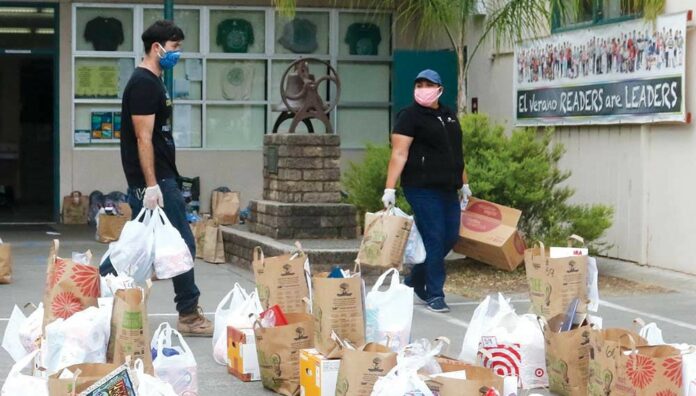It’s cliche to say it, but the Covid-19 pandemic has revealed all sorts of societal inequalities. In Sonoma County, there is plenty of overlap between the pre-existing societal ills and the ongoing ones brought about by the pandemic.
Food For All – Comida Para Todos is an all-volunteer group which has delivered thousands of packages of food and other necessities to residents in Southeast Sonoma County throughout the first eight months of the Covid-19 pandemic.
The group formed in an effort to fill what the group’s organizers say is a long-standing lack of resources for the residents of one of the county’s poorest and most densely-populated communities, the unincorporated areas outside of the City of Sonoma commonly known as The Springs.
Members of Food For All worked together, offering aid to residents after the October 2017 wildfires, and sprang into action again this March when they realized that nonprofits and public agencies were again failing to provide the aid that some community members in the unincorporated areas west of the City of Sonoma needed.
As food lines swelled across the nation, Food For All’s organizers realized that many residents of the unincorporated areas outside of the City of Sonoma could not access a centralized drive-up food distribution location at the Hanna Boys Center because they did not have cars.
D’Mitra Smith, one of the group’s organizers, sees the work as an effort to fill in a longstanding lack of support for the families of the hardworking, but often low-paid, workers who live in the areas they serve.
“There is no safety net for, you know, vineyard workers, their families, immigrant communities, [and] undocumented people [who live in Sonoma County],” Smith said in a recent interview with other organizers.
Food For All, which is fiscally sponsored by the North Bay Organizing Project, differs from other nonprofits in several ways.
Instead of relying on an executive director to make top-down decisions, important choices at Food For All – Comida Para Todos are made collectively. The group also avoids using images of people in poverty to receive additional financial support, an exploitative-if-well-intentioned marketing practice known as “poverty porn.”
Put simply, the group focuses on what organizer Celeste Winders calls “justice work”: providing people in need with food and other necessities with no strings or expectations attached.
“Our role is to find out what people need, to get them what they need, and to treat them with respect and dignity and honor their autonomy, honor their privacy and honor who they are,” Winders said.
The group, which includes about two dozen regular volunteer organizers and drivers, now regularly delivers two kinds of packages: one of food and another of necessities, including menstrual products, diapers and toilet paper.
Although they offer deliveries anywhere between the eastside of Sonoma and Glen Ellen, Cameron Iturri-Carpenter, one of the group’s organizers, estimates that 90 to 95 percent of the requests the group receives are from The Springs, a group of small communities outside the city limits of Sonoma, and the nearby El Verano community.
It shouldn’t be too surprising that the combined health and economic crises have hit the area hard. A 2014 report titled “A Portrait of Sonoma County,” found that residents of Fetters Springs-Agua Caliente West, one community in The Springs, had the third-lowest median income in Sonoma County. Residents of those communities had an individual median income of $19,444 compared to the countywide median income of $30,214, according to 2012 statistics cited in the report.
Moreover, the report states that “Rental housing in Fetter Springs/Agua Caliente is crowded; it ties Sheppard [in Southwest Santa Rosa] as the census tract with the largest household size among those who are renting their homes—4.5 people—compared to 2.6 people Sonoma County–wide.” El Verano, which neighbors Fetters Springs, had a closer-to-average rental housing density rate, according to the report.
While the county Health Department currently only releases zip code–level data, the available numbers indicate that the county’s low-income and densely populated areas consistently have high numbers of cases.
As of Tuesday, Nov. 9, the 95476 zip code, which includes the Springs and the City of Sonoma, had the fifth highest rate of active Covid-19 cases, with seven percent of the county’s total cases to date. The 95407 zip code, which includes Sheppard, the Southwest Santa Rosa neighborhood which tied the Springs for population density in rental units in the 2014 report, had the highest rate of active cases in the county, with 18 percent of total cases to date.











